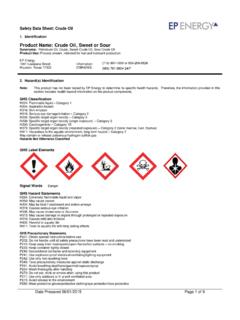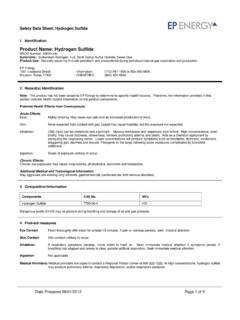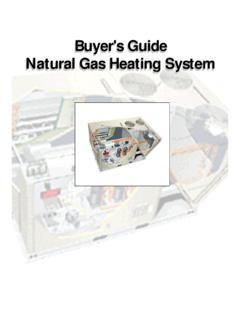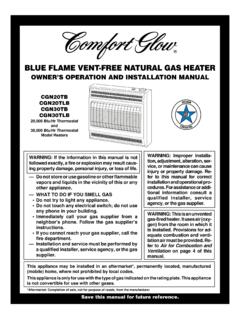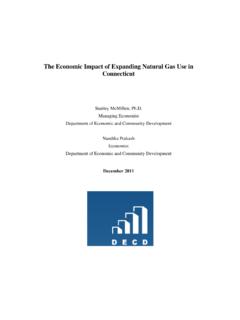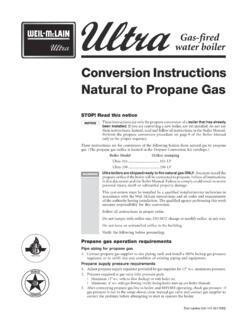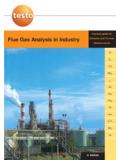Transcription of Product Name: Natural Gas Liquids/Condensates
1 Safety Data Sheet: Natural Gas Liquids/Condensates Date Prepared 06/01/2015 Page 1 of 9 Name: Natural Gas Liquids/Condensates Synonyms: Natural Gas Liquids, Sweet, Condensate, Natural gasoline Product Use: Oil and Natural gas production liquids EP Energy 1001 Louisiana Street Information: Houston, Texas 77002 O'BRIEN'S:(985) 781-0804 24/72. Hazard(s) IdentificationNote: This material has not been tested by EP Energy to determine its specific health hazards. Therefore, the information provided in this section includes health hazard information on the Product components. GHS Classification H225: Flammable Liquids - Category 2 H331: Acute Toxicity Inhalation - Category 3 H340: Germ Cell Mutagenicity - Category 1B H350: Carcinogenicity - Category 1A H371: Specific Target Organ Toxicity Single Exposure - Category 3 H372: Specific Target Organ Toxicity Repeat Exposure - Category 1 H304: Aspiration Toxicity - Category 1 H336: Specific Target Organ Toxicity H402: Toxic to the Aquatic Environment Acute - Category 3 GHS LABEL ELEMENTS Signal Word Danger GHS Hazard Statements H225: Highly flammable liquid and vapor.
2 H331: Toxic if inhaled. H340: May cause genetic defects. H350: May cause cancer. H371: May cause damage to organs H372: Causes damage to organs through prolonged or repeated exposure H304: May be fatal if swallowed and enters airways. H336: May cause drowsiness or dizziness. H402: Harmful to aquatic life GHS Precautionary Statements Prevention P201: Obtain special instructions before use P210: Keep away from heat/sparks/open flames/hot surfaces. No smoking P233: Keep container tightly closed. P240: Ground/bond container and receiving equipment. P241: Use explosion-proof electrical/ventilating/lighting/equipmen t. P242: Use only non-sparking tools. P243: Take precautionary measures against static discharge.
3 P280: Wear protective gloves/protective clothing/eye protection/face protection. P260: Do not breathe fume/gas/mist/vapors/spray. P264: Wash thoroughly after handling. P270: Do not eat, drink or smoke when using this Product . P271: Use only outdoors or in well-ventilated area. P201: Obtain special instructions before use. P202: Do not handle until all safety precautions have been read and understood. P273: Avoid release to the environment. (713) 997-1000 or 855-269-0826 Safety Data Sheet: Natural Gas Liquids/Condensates Date Prepared 06/01/2015 Page 2 of 9 P280: Wear protective gloves/protective clothing/eye protection/face protection Response P303: IF ON SKIN (or hair): Wash with plenty of soap and water.
4 Remove/Take off immediately all contaminated clothing. Rinse skin with water/shower. P304: IF INHALED: Remove victim to fresh air and keep comfortable for breathing. Call a poison center/doctor. P301: IF SWALLOWED: Immediately call a POISON CNETER or doctor/physician. Do not induce vomiting. P308: IF exposed or concerned: Get medical advice/attention. P370: In case of fire: Use dry chemical, carbon dioxide, or foam for extinguishing. Storage P233: Keep container tightly closed P405: Store locked up Disposal P391: Collect spillage P501: Dispose of contents/container in accordance with local/regional/national/international regulations. 3. Composition/Information on Ingredients Note: Composition will vary with geographic location, geologic formation, temperature and pressure.
5 Components CAS No. Wt%(1) Propane 74-98-6 20-60 Ethane 74-84-0 1-60 n-Pentane 109-66-0 5-25 n-Hexane 110-54-3 2-13 Heptane 142-82-5 1-10 Octane 111-65-9 1-10 n-Butane 106-97-8 2-5 Cyclohexane 110-82-7 1-5 Toluene 108-88-3 Ethyl benzene 100-41-4 Xylenes 1330-20-7 Benzene 71-43-2 0-2 Hydrogen Sulfide 7783-06-4 Varies (1)Normal composition ranges are shown. Exceptions may occur depending upon the source of the condensate. 4. First-Aid Measures Inhalation: If respiratory symptoms develop, move victim to fresh air. Seek immediate medical attention if symptoms persist. If breathing has stopped and airway is clear, provide artificial respiration. Do not use mouth-to-mouth method if victim ingested the substance.
6 Provide artificial respiration with the aid of a pocket mask equipped with a one-way valve or other proper respiratory medical device. Administer oxygen if breathing is difficult, if qualified. Seek immediate medical attention. Skin Contact: Remove and isolate contaminated clothing and shoes. Wash affected areas with soap and water. If irritation persists, seek medical attention. Decontaminate clothing before reuse. Eye Contact: Flush eyes with large amounts of water for at least 15 minutes, occasionally lifting the eyelids. Seek medical attention. Ingestion: DO NOT INDUCE VOMITING. If spontaneous vomiting occurs, place on the left side with head down to prevent aspiration of liquid into the lungs. Have exposed individual rinse mouth thoroughly with water.
7 Never give anything by mouth to an unconscious person. Do not leave victim unattended. Monitor for breathing difficulties. Seek immediate medical attention. Notes to Physician: This material may contain or liberate hydrogen sulfide. In high doses, hydrogen sulfide may produce pulmonary edema and respiratory depression or paralysis. 5. Fire-Fighting Measures NFPA Ratings: Health: 2 Flammability: 4 Reactivity: 0 General Fire Hazards: Safety Data Sheet: Natural Gas Liquids/Condensates Date Prepared 06/01/2015 Page 3 of 9 Extremely flammable. Easily ignited by heat, sparks or flames or other sources of ignition. Flowing condensates can be ignited by self-generated static electricity.
8 Containers should be grounded and bonded. Vapors from liquefied gas are initially heavier than air and spread along ground. Vapors may reach an ignition source, and flashback. Runoff to sewer may create fire or explosion hazard downstream from the source. Gases may form explosive mixtures with air. BLEVE'S (Boiling Liquid Expanding Vapor Explosions) can occur when a liquid in a pressurized container is heated to temperatures beyond its boiling point. This can lead to failure of the container and damage to the surrounding area. Hazardous combustion/decomposition products may include carbon monoxide, carbon dioxide, hydrocarbons, nitrogen oxides, and sulfur oxides. Hydrogen sulfide may be present.
9 Downwind personnel must be evacuated. Extinguishing Media: Class B fire extinguisher, dry chemical, fire-fighting foam or carbon dioxide. Carbon dioxide can displace oxygen. Use caution when applying carbon dioxide in confined spaces. For large fires, use water spray, fog or fire- fighting foam. Water may be ineffective for fighting the fire, but may be used to keep fire-exposed containers or surrounding areas cool. Unsuitable Extinguishing Media: Water may be ineffective for fighting the fire, but may be used as a spray to keep surroundings area cool. Specific Hazards During Fire Fighting: Extremely flammable. Fire may produce irritating, corrosive and/or toxic gases. Fire Fighting Instructions: Do not extinguish a leaking gas flame unless the leak can be stopped.
10 Allow gas to burn out. Promptly isolate the scene by removing all persons from the vicinity of the incident. Move containers from fire area if you can do it without risk. Use a smothering technique for extinguishing fire of this flammable liquid. Do not use a forced- water stream directly on the Natural gas liquids (condensate) fires as this will scatter the fire. Use a water spray to cool fire-exposed containers and surrounding areas until well after fire is out. Do not direct water at source of leak or safety devices as icing may occur. Prevent runoff from fire control or dilution from entering streams, sewers or drinking water supply. Dike fire-control water for containment and recovery. Firefighters should wear self-contained breathing apparatus and full protective clothing.
